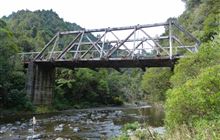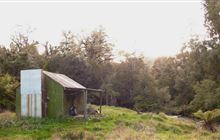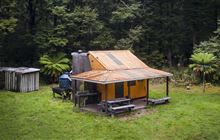Introduction
Explore the historic heritage sites that DOC looks after in East Coast region.
Manganuku Stream Bridge
Built in 1928 the bridge is a Public Works Department standard design, single-lane, single-span truss road bridge built of Australian hardwood.

Te Totara Hut
This is a standard six-bunk hut in the Te Urewera area. This historic hut was built for deer culler accommodation in 1952.

Puhi Kai Iti/Cook Landing National Historic Reserve
Puhi Kai Iti commemorates the first landing place of James Cook in New Zealand in 1769. It also commemorates the Horouta and Te Ikaroa-a-Rauru waka (canoes) which carried Māori to the district.

Rogers Hut (Te Wairoa)
Built for deer cullers in 1952, Rogers Hut is one of only three remaining slab-beech huts in the Urewera Range. This is a standard six-bunk hut, near the border of the Te Urewera.

History of Tauranga Bridge
The historic Tauranga Bridge is the only surviving harp suspension bridge left in New Zealand.
Specific historical themes relating to the region are:
- Exploring the land e.g. Cook Landing Site National Historic Reserve
- Pathways through the land e.g. Manganuku Bridge
- Harvest and Exploitation of Marine Mammals - e.g. Whakaari
- Patterns of settlement - e.g. Otatara, Kuripapango
- Relationship to the natural environment - e.g. Mansons Hut
- Conflict and defence - e.g. Onepoto
For centuries Te Urewera has been home to the Tuhoe people or the 'Children of the Mist' in reference to the tradition that they are the offspring of Hine-puhoku-rangi - the celestial mist maiden. Maori heritage in the area is of great significance and Maori retain a powerful presence here. DOC manages, in association with Maori, a range of historic heritage including pa and taonga held in a museum at Aniwaniwa Visitors Centre. The concept of working with iwi is central to the area's approach to managing historic heritage.
The traumatic period of the New Zealand wars is represented on conservation land by two redoubt and a sunken boat in Lake Waikaremoana.
European history has great significance within the area. Captain Cook first made landfall in New Zealand at Poverty Bay in 1769 and the world known to Maori changed overnight. DOC manages the Cook Landing Site National Historic Reserve and is currently working towards greater Maori community association with the site.
The settlement and enterprise of early colonisation is represented through the Tauranga and Manganuku Bridges in the Waioweka Gorge and remnants of settlement at Kuripapango.
DOC manages an unparalleled collection of historic huts in Hawke’s Bay remaining from a period of extensive pastoral runs and early wild animal control activities.
East Cape
There is a long history of intensive and sustained Maori occupation of the East Cape area, archaeologically evidenced in numerous pa and shell midden. This area includes the northern section of Te Urewera which is the homeland of the Tuhoe iwi who descended from the Potiki people and the descendants of those who travelled in the Mataatua waka from Hawaiki to Whakatane. Other iwi historically identified with the East Cape area include Whakatohea, Ngai Ta, Te Whanau-a-Apanui, Te Whanau-a-Te Ehutu and Ngati Porou.
European settlement of Opotiki dates from the establishment of a mission station in 1860.
Coastal shipping of garden produce to support Auckland's growing population is a feature of the history of this area. Whaling was another major activity in the late 19th century with significant whaling stations established at several key locations.
Te Urewera
The Te Urewera area is dominated by Lake Waikaremoana, which is highly significant to the Ruapani, Tuhoe and Kahungungu iwi. Over the past centuries, tribes now collectively known as Tuhoe have retained control over the Urewera forests.
European missionaries ventured into the Urewera region from the 1840s, and there were several ill-fated military campaigns mounted against the Maori leader Te Kooti who sought refuge there with his followers during the late 1860s and early 1870's.
Tourist traffic to Lake Waikaremoana began from Wairoa in the 1880s, with accommodation provided at Aniwaniwa in 1903 (the Lake House). Timber milling began in the 1900s and by 1922 many lands were consolidated to protect them from exploitation. The 1900s also saw Rua Kenana establish a community based on the Ihiraira Ringatu faith at Maungapohatu. The settlement was abandoned in the 1950s but the area is still used for pastoral farming.
Gisborne
The Gisborne area has been heavily settled over time, by both Maori and European. Maori had an economy based on fishing and the cultivation of kumara, yams and taro. Iwi historically identified with the region are Ngati Porou, Te Aitanga-a-Mahaki, Te Aitanga-a-Hauiti, Rongowhakaata, Ngai Tamanuhiri and Ngati Kahungunu.
Captain Cook first made landfall in New Zealand at Tūranginui-a-Iwi/Poverty Bay in 1769 and the world known to Maori changed overnight. Coastal trading and whaling stations were established along the coast from the 1830's, while pastoral farming developed inland.